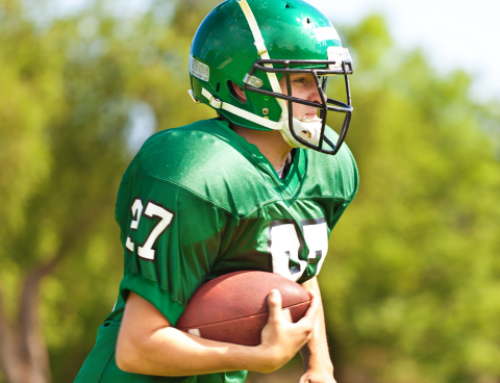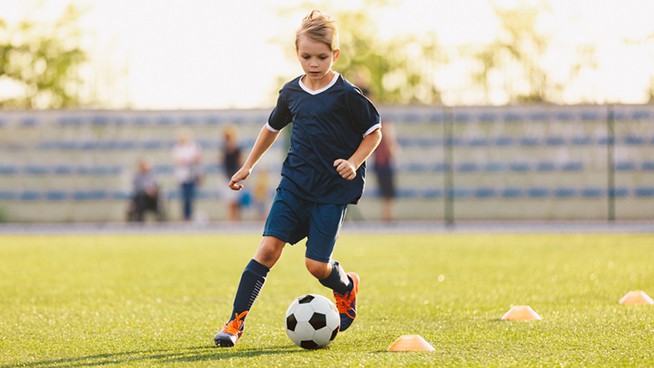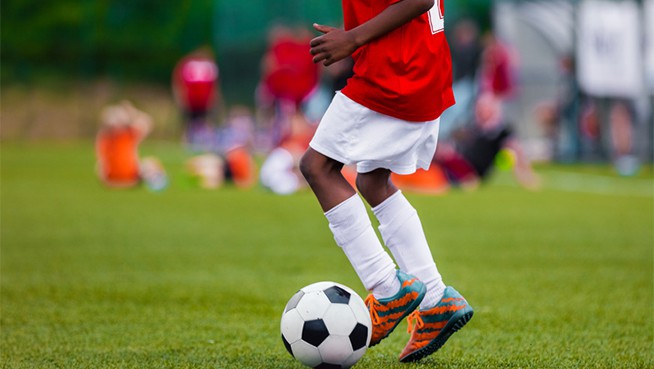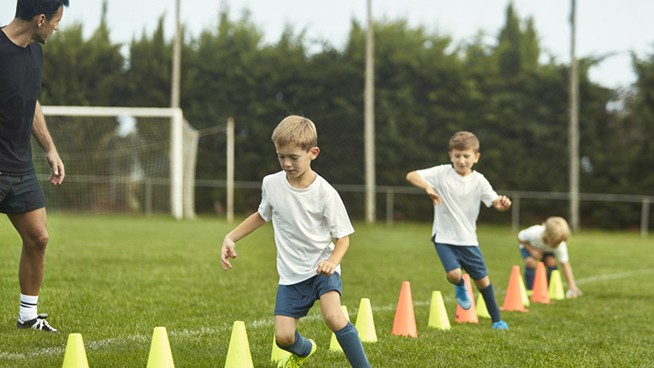Drew Brees and Others Advocate for imPACT Baseline Concussion Testing

(from left to right) Drew Brees, Briana Scurry, Carl Banks and Mike Richter
PACE, which stands for Protecting Athletes through Concussion Education, is a nationwide program that informs young athletes, parents and coaches about the dangers of concussions in sports. PACE also provides baseline neurocognitive testing for schools and youth athletic programs.
What Is Baseline Neurocognitive Testing?
Baseline neurocognitive testing is a tool that helps health care professionals make better decisions about when to put an athlete back on the field. “Concussions can be very, very tricky to diagnose,” said panelist Dr. Mark Lovell, renowned neuropsychologist, concussion expert and creator of the imPACT test—the first, most widely used and most scientifically validated computerized concussion evaluation system.
The imPACT baseline test establishes metrics for an athlete’s normal health. If an injury occurs, a doctor can easily compare test performance with the normal health baseline to determine the severity of the concussion and whether the athlete is ready to get back in the game. The 20-minute test evaluates multiple aspects of brain function, including memory, processing speed, reaction time, and post-concussive symptoms.
Establishing a baseline is important, because sometimes athletes don’t even know they’ve had a concussion. According to the American College of Sports Medicine, approximately 85 percent of all concussions are undiagnosed—an estimated 3.8 million youth-sports-related concussions each year. With the help of the Dick’s Sporting Goods Foundation, imPACT has been distributed to thousands of middle and high schools, as well as to collegiate and pro sports teams.
Concussion Awareness
Concussion awareness is a rapidly evolving aspect of sports culture. Twenty years ago, “you were thought of as ‘un-tough’ if you couldn’t get back in after a game,” said NFL veteran Banks. “If you were knocked out in a game, you were expected to play the next game, no questions asked.”
When Brees sustained a concussion in 2005, he remained in the game until the middle of the fourth quarter. “I didn’t take myself out, I was pulled out,” says Brees. “I think, due to the mentality of a lot of athletes—and I think this is probably going to be the toughest challenge that we’ll face—nobody ever wants to pull themselves out of a game. You feel like you’re letting the team down; it’s a pride thing, and that’s what makes great players great—that invincible mentality.”
Hall-of-fame hockey goaltender Richter, whose career was finished (after possible prior concussions) when he suffered a fractured skull in 2002, expanded on that note, saying, “Most athletes young and old will say, ‘I’m ready to play.’ It’s part of a code of conduct.” Richter and Brees went on to stress the importance of having an objective, independent presence—someone on the sidelines always looking out for the athletes’ best interests. “Even trainers are often under pressure to keep the best players on the field,” said Banks, noting that his only recorded concussion occurred in his rookie year, when he ended up putting himself back in the game by the fourth quarter.
Besides football, two sports where concussion awareness has grown significantly over the past decade are hockey and soccer. Retired U.S. national soccer team goalkeeper Scurry, whose career was terminated after a knee-to-head injury, noted that she was required to undergo baseline testing in 2002, when she played internationally. According to recent studies, the pace at which concussions have been occurring in women’s soccer is second only to NFL football. Concerning the long-term effects of repeated (however minor) blows to the head, Scurry wondered, “Are they teaching young girls the proper way to head the ball?”
Prevention
Can concussions be prevented? Are athletes at greater risk for a concussion if they’ve already sustained one? What measures should athletes, coaches, and parents take to protect themselves? “We’re never going to be able to completely eliminate the risk,” said Brees. “We do things with proper equipment, with less hitting and contact exposure in practice, and that kind of thing, but there’s always going to be the risk of head injuries in sports.” All four athletes concurred that it comes down to one key factor—the coaching: teaching proper technique (e.g., for tackling) and reinforcing the fundamentals as much as possible. “There’s a shift [in awareness] that needs to occur,” continued Brees.
Whether better training will come from certifying coaches or having them take some type of credentials test is yet to be determined. What can be done—and is being done through imPACT PACE—is identifying the risks and properly treating those with concussion symptoms until they are 100 percent ready to play. Especially for young athletes, whose brains and cognitive abilities are still developing rapidly, baseline testing should become an essential part of the yearly physical required for eligibility.
Still coping with various long-term symptoms such as blurry vision, slurred speech, imbalance, headaches and anxiety, Scurry remarked, “As an athlete you have a connection to your body, your mind and how you perform and play. And you feel an energy connection to your teammates as well, through which you can get the job done. In the case of my concussion, that connection was severed. It has never come back.”
Follow PACE and check out STACK’s Concussion Guide for more information on preventing concussions.
RECOMMENDED FOR YOU
MOST POPULAR
Drew Brees and Others Advocate for imPACT Baseline Concussion Testing

(from left to right) Drew Brees, Briana Scurry, Carl Banks and Mike Richter
PACE, which stands for Protecting Athletes through Concussion Education, is a nationwide program that informs young athletes, parents and coaches about the dangers of concussions in sports. PACE also provides baseline neurocognitive testing for schools and youth athletic programs.
What Is Baseline Neurocognitive Testing?
Baseline neurocognitive testing is a tool that helps health care professionals make better decisions about when to put an athlete back on the field. “Concussions can be very, very tricky to diagnose,” said panelist Dr. Mark Lovell, renowned neuropsychologist, concussion expert and creator of the imPACT test—the first, most widely used and most scientifically validated computerized concussion evaluation system.
The imPACT baseline test establishes metrics for an athlete’s normal health. If an injury occurs, a doctor can easily compare test performance with the normal health baseline to determine the severity of the concussion and whether the athlete is ready to get back in the game. The 20-minute test evaluates multiple aspects of brain function, including memory, processing speed, reaction time, and post-concussive symptoms.
Establishing a baseline is important, because sometimes athletes don’t even know they’ve had a concussion. According to the American College of Sports Medicine, approximately 85 percent of all concussions are undiagnosed—an estimated 3.8 million youth-sports-related concussions each year. With the help of the Dick’s Sporting Goods Foundation, imPACT has been distributed to thousands of middle and high schools, as well as to collegiate and pro sports teams.
Concussion Awareness
Concussion awareness is a rapidly evolving aspect of sports culture. Twenty years ago, “you were thought of as ‘un-tough’ if you couldn’t get back in after a game,” said NFL veteran Banks. “If you were knocked out in a game, you were expected to play the next game, no questions asked.”
When Brees sustained a concussion in 2005, he remained in the game until the middle of the fourth quarter. “I didn’t take myself out, I was pulled out,” says Brees. “I think, due to the mentality of a lot of athletes—and I think this is probably going to be the toughest challenge that we’ll face—nobody ever wants to pull themselves out of a game. You feel like you’re letting the team down; it’s a pride thing, and that’s what makes great players great—that invincible mentality.”
Hall-of-fame hockey goaltender Richter, whose career was finished (after possible prior concussions) when he suffered a fractured skull in 2002, expanded on that note, saying, “Most athletes young and old will say, ‘I’m ready to play.’ It’s part of a code of conduct.” Richter and Brees went on to stress the importance of having an objective, independent presence—someone on the sidelines always looking out for the athletes’ best interests. “Even trainers are often under pressure to keep the best players on the field,” said Banks, noting that his only recorded concussion occurred in his rookie year, when he ended up putting himself back in the game by the fourth quarter.
Besides football, two sports where concussion awareness has grown significantly over the past decade are hockey and soccer. Retired U.S. national soccer team goalkeeper Scurry, whose career was terminated after a knee-to-head injury, noted that she was required to undergo baseline testing in 2002, when she played internationally. According to recent studies, the pace at which concussions have been occurring in women’s soccer is second only to NFL football. Concerning the long-term effects of repeated (however minor) blows to the head, Scurry wondered, “Are they teaching young girls the proper way to head the ball?”
Prevention
Can concussions be prevented? Are athletes at greater risk for a concussion if they’ve already sustained one? What measures should athletes, coaches, and parents take to protect themselves? “We’re never going to be able to completely eliminate the risk,” said Brees. “We do things with proper equipment, with less hitting and contact exposure in practice, and that kind of thing, but there’s always going to be the risk of head injuries in sports.” All four athletes concurred that it comes down to one key factor—the coaching: teaching proper technique (e.g., for tackling) and reinforcing the fundamentals as much as possible. “There’s a shift [in awareness] that needs to occur,” continued Brees.
Whether better training will come from certifying coaches or having them take some type of credentials test is yet to be determined. What can be done—and is being done through imPACT PACE—is identifying the risks and properly treating those with concussion symptoms until they are 100 percent ready to play. Especially for young athletes, whose brains and cognitive abilities are still developing rapidly, baseline testing should become an essential part of the yearly physical required for eligibility.
Still coping with various long-term symptoms such as blurry vision, slurred speech, imbalance, headaches and anxiety, Scurry remarked, “As an athlete you have a connection to your body, your mind and how you perform and play. And you feel an energy connection to your teammates as well, through which you can get the job done. In the case of my concussion, that connection was severed. It has never come back.”
Follow PACE and check out STACK’s Concussion Guide for more information on preventing concussions.














